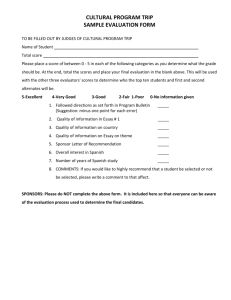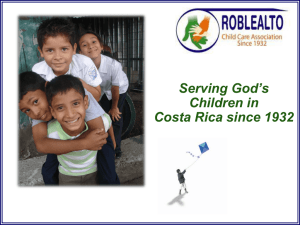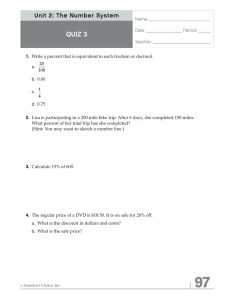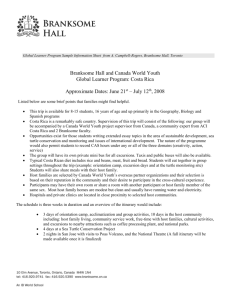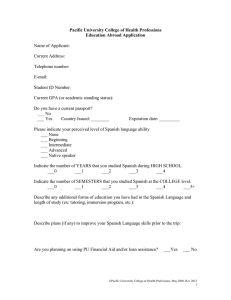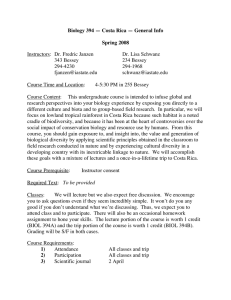International Student Volunteer Adventure in Costa Rica by TESOL intern Arie Bachmann
advertisement
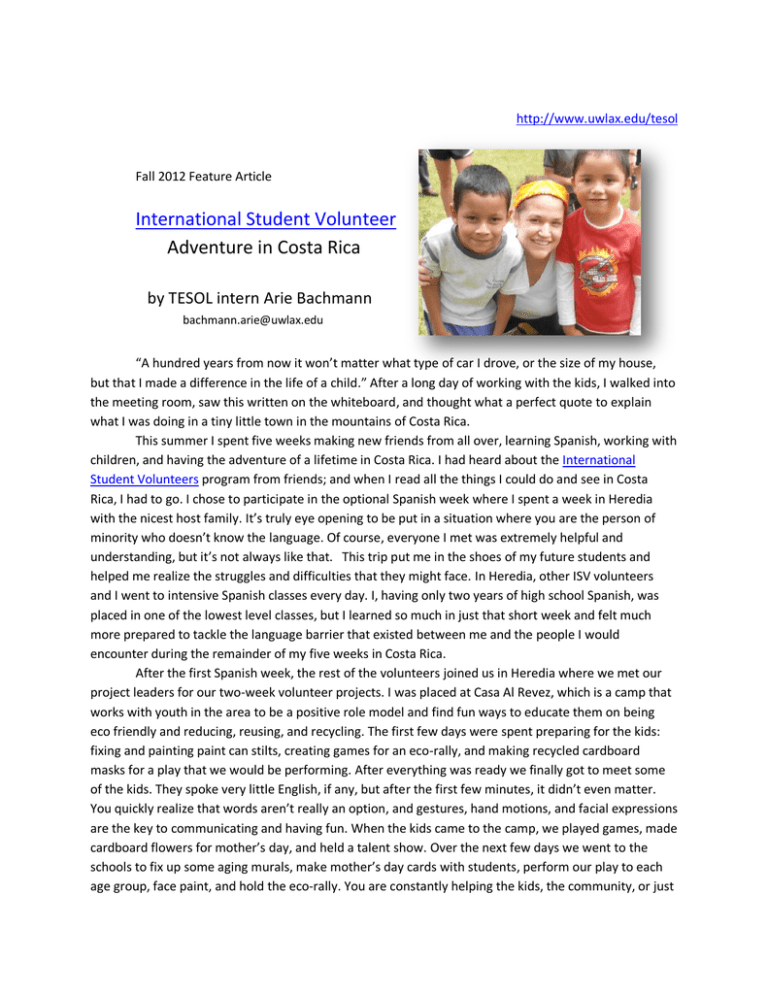
http://www.uwlax.edu/tesol Fall 2012 Feature Article International Student Volunteer Adventure in Costa Rica by TESOL intern Arie Bachmann bachmann.arie@uwlax.edu “A hundred years from now it won’t matter what type of car I drove, or the size of my house, but that I made a difference in the life of a child.” After a long day of working with the kids, I walked into the meeting room, saw this written on the whiteboard, and thought what a perfect quote to explain what I was doing in a tiny little town in the mountains of Costa Rica. This summer I spent five weeks making new friends from all over, learning Spanish, working with children, and having the adventure of a lifetime in Costa Rica. I had heard about the International Student Volunteers program from friends; and when I read all the things I could do and see in Costa Rica, I had to go. I chose to participate in the optional Spanish week where I spent a week in Heredia with the nicest host family. It’s truly eye opening to be put in a situation where you are the person of minority who doesn’t know the language. Of course, everyone I met was extremely helpful and understanding, but it’s not always like that. This trip put me in the shoes of my future students and helped me realize the struggles and difficulties that they might face. In Heredia, other ISV volunteers and I went to intensive Spanish classes every day. I, having only two years of high school Spanish, was placed in one of the lowest level classes, but I learned so much in just that short week and felt much more prepared to tackle the language barrier that existed between me and the people I would encounter during the remainder of my five weeks in Costa Rica. After the first Spanish week, the rest of the volunteers joined us in Heredia where we met our project leaders for our two-week volunteer projects. I was placed at Casa Al Revez, which is a camp that works with youth in the area to be a positive role model and find fun ways to educate them on being eco friendly and reducing, reusing, and recycling. The first few days were spent preparing for the kids: fixing and painting paint can stilts, creating games for an eco-rally, and making recycled cardboard masks for a play that we would be performing. After everything was ready we finally got to meet some of the kids. They spoke very little English, if any, but after the first few minutes, it didn’t even matter. You quickly realize that words aren’t really an option, and gestures, hand motions, and facial expressions are the key to communicating and having fun. When the kids came to the camp, we played games, made cardboard flowers for mother’s day, and held a talent show. Over the next few days we went to the schools to fix up some aging murals, make mother’s day cards with students, perform our play to each age group, face paint, and hold the eco-rally. You are constantly helping the kids, the community, or just having so much fun with your volunteer group that you don’t have time to think about missing home. Our last day with the children was spent playing all sorts of games on the town soccer field. It’s amazing how quickly all the volunteers get attached to the kids as well as each other. This experience gave me the unique opportunity to not only see how people in another country live and act, but also people from other states in the U.S. and Canada. During the volunteer project we got two free days that were spent in nearby cities where we went on a coffee tour, paintballing, and to an extreme adventure park (high ropes activities). ISV offers so many opportunities to do things you might never have an opportunity to do otherwise and every bit of it is worth the price. After the volunteer portion of the trip we had the option to go on a two-week adventure tour around the country, which I opted to do. We started off heading to the Caribbean side, then up to the mountains in the north, over to the Pacific side, and finally back to the capital, San Jose, for our departure. We got the chance to see huge volcanoes, incredible wildlife, and actual rainforests, but that’s not all. During those two weeks we went white water rafting through one of the top five rafting rivers in the world, hiking, sliding down a waterfall, tubing down rapids, horseback riding, zip lining, rappelling, surfing, kayaking, and relaxed at a mud spa, two hot springs, and multiple gorgeous beaches. We stayed in a new place about every two nights and were treated like royalty in the each of the locations. Not to mention, I left with over twenty new and amazing friends that helped make my experience as life changing as it was. Every time I explain my trip to people, I feel like I’m bragging or trying to make it sound unbelievably fun, but it truly is even more fun than I can describe and you learn so much about the other culture as well as about yourself. There are a lot of UW-L students who go on various ISV projects every year, in just my group there were two other La Crosse students that I hadn’t met prior to my trip. The International Student Volunteers (ISV) website explains how to make payments and any other information you may need to know about your specific trip. After you complete one trip with ISV, you have the opportunity to become a student rep and receive money towards your next trip for helping others sign up. I obviously loved my trip and am already trying to decide on where to go for my next one, so I became a student rep and would be happy to talk with anyone who is even just interested in hearing more about the program, my experience, or how to sign up on your own trip. The best way to get an idea of what a English language learner might be feeling and thinking while learning English and being in a completely new culture is to put yourself through a similar experience. Even the people on my trip who knew Spanish before they came got a chance to fully experience the Costa Rican culture and practice there Spanish with tons of native speakers. For more information about International Student Volunteers, contact Arie Bachmann at bachmann.arie@uwlax.edu .
